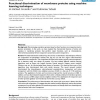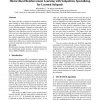269 search results - page 9 / 54 » A Minimax Method for Learning Functional Networks |
NIPS
1992
13 years 8 months ago
1992
How can artificial neural nets generalize better from fewer examples? In order to generalize successfully, neural network learning methods typically require large training data se...
BMCBI
2008
13 years 7 months ago
2008
Background: Discriminating membrane proteins based on their functions is an important task in genome annotation. In this work, we have analyzed the characteristic features of amin...
NCI
2004
13 years 9 months ago
2004
This paper describes a method for hierarchical reinforcement learning in which high-level policies automatically discover subgoals, and low-level policies learn to specialize for ...
COLING
2010
13 years 2 months ago
2010
This paper presents a novel semisupervised learning algorithm called Active Deep Networks (ADN), to address the semi-supervised sentiment classification problem with active learni...
CVPR
2009
IEEE
15 years 2 months ago
2009
IEEE
We address the problem of label assignment in computer
vision: given a novel 3-D or 2-D scene, we wish to assign a
unique label to every site (voxel, pixel, superpixel, etc.). To...


